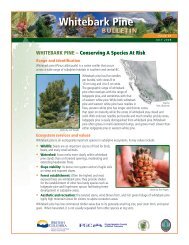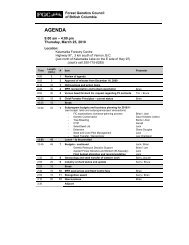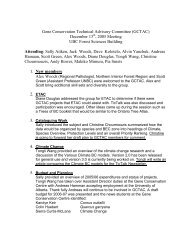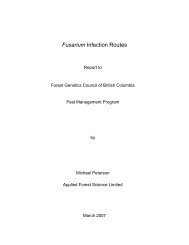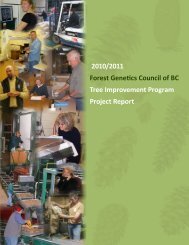Tree Improvement Program Project Report 2006 / 2007
Tree Improvement Program Project Report 2006 / 2007
Tree Improvement Program Project Report 2006 / 2007
Create successful ePaper yourself
Turn your PDF publications into a flip-book with our unique Google optimized e-Paper software.
complete report on pollen capture at all five stations for Hw<br />
and Ss for <strong>2006</strong> is available for project SPU 0313 (<strong>2006</strong>)<br />
from the OTIP coordinator.<br />
Methods<br />
The ministry standard for monitoring pollen cloud<br />
density uses seven-day recorders (see Webber and Painter<br />
1996) mounted on rotating platforms at 3 m height.<br />
Daily pollen catch was expressed as the number of pollen<br />
grains per mm 2 . Five pollen monitoring stations were<br />
used in the Saanich peninsula, which correspond to the<br />
same stations used by the Ministry of Forests and Range,<br />
<strong>Tree</strong> <strong>Improvement</strong> Branch, for their annual regional<br />
pollen monitoring of coastal Douglas-fir pollen. Bruce<br />
MacPherson (MoF Coastal Seed Orchards) was responsible<br />
for maintaining the five Saanich peninsula monitoring<br />
stations (erecting monitors, changing charts).<br />
We counted two replicates on each chart for a 24-hour<br />
period and averaged the total number of pollen grains for<br />
the two replicates. To determine the pollen cloud density,<br />
we then divided the average daily counts by 44 mm 2<br />
to represent the number of pollen grains per mm 2 for a<br />
24-hour period. We also compared results for regional<br />
monitoring of western hemlock and Sitka spruce pollen<br />
flight with the receptivity periods and pollen cloud density<br />
values monitored at the Western Forest Products (WFP)<br />
Saanich seed orchard site (Hw orchard 170 and Ss<br />
orchard 172).<br />
Results<br />
Figure 49 shows the daily western hemlock pollen cloud<br />
density values averaged over the five Saanich peninsula<br />
stations. Figure 50 shows the daily Sitka spruce pollen<br />
cloud density values averaged over the same five stations.<br />
In <strong>2006</strong>, the mean western hemlock pollen shed on the<br />
Saanich peninsula ranged from March 24 to April 30. The<br />
period of Sitka spruce pollen shed was April 14 to April 30<br />
(the end of regional monitoring, although WFP orchard<br />
172 continued to shed for one more week). Table 17 shows<br />
the total pollen load for western hemlock and Sitka spruce<br />
in years 2005 and <strong>2006</strong>. Pollen load represents the daily<br />
pollen cloud density summed over the monitoring period.<br />
Compared to 2005, pollen capture for the western hemlock<br />
and Sitka spruce was about 20 percent and 50 percent<br />
lower, respectively, than in 2005.<br />
The total regional pollen load (mean for all five stations)<br />
for western hemlock and Sitka spruce for the six-week<br />
monitoring period was 9.2 and 1.9 and 1.6 and 0.8 pollen<br />
0<br />
T R E E I M P R O V E M E N T P R O G R A M<br />
P R O J E C T R E P O R T 2 0 0 6 / 2 0 0 7<br />
grains/mm 2 for each of 2005 and <strong>2006</strong>, respectively.<br />
Although the corresponding values for pollen load<br />
for the receptivity period of WFP orchards 170 and 172<br />
are not strictly comparable (slide counts versus seven-day<br />
recorder counts), we can still estimate potential western<br />
hemlock pollen contamination from slide counts taken<br />
within the orchard and regional counts from the Saanich<br />
peninsula. Table 18 shows the pollen load (mean for all five<br />
stations) from regional counts during the receptivity period<br />
2005 and <strong>2006</strong>.<br />
The corresponding pollen load values (regional) for<br />
western hemlock and Sitka spruce were 1.3 and 1.0 and<br />
0.3 and 0.7 grains/mm 2 , respectively. Table 19 shows the<br />
corresponding values for pollen load (orchard) summed<br />
over the receptivity period of western hemlock orchard 170<br />
and Sitka spruce orchard 172 (slides).<br />
According to Woods et al (1996), regional pollen<br />
capture for the receptivity period of the orchard is adjusted<br />
for the differences in capture efficiency between the regional<br />
monitors (seven-day) and the orchard monitors (slides).<br />
The orchard adjustment factor (OAF) is determined by<br />
averaging the ratio of daily pollen capture of the orchard<br />
slides to the regional seven-day monitors. Thus, by<br />
averaging the early orchard pollen capture (EOA) to the<br />
early regional average (ERA) for a period of seven to ten<br />
days (prior to orchard pollen flight), a factor is calculated<br />
that can be applied to the regional counts for the orchard<br />
receptivity period. However, in practice the calculation of<br />
the OAF has been inconsistent. Often there are not enough<br />
days prior to orchard shed to give a reliable result (regional<br />
shed and orchard receptivity period overlap). Because<br />
of this, the OAF was not considered in the following<br />
calculations of percent contamination. Table 20 shows<br />
the estimate of percent contamination for both western<br />
hemlock and Sitka spruce using only the regional pollen<br />
counts and orchard counts.<br />
Conclus on<br />
For both 2005 and <strong>2006</strong>, the pollen counts for western<br />
hemlock were lower than those observed for Douglasfir<br />
and significantly lower for Sitka spruce. For example,<br />
regional pollen loads for the six-week monitoring period<br />
for Douglas-fir in 2005 and <strong>2006</strong> was 18.3 and 15.0<br />
grains/mm 2 , respectively. This corresponded to an estimate<br />
of percent contamination (no OAF) of 4.8 and 12.3,<br />
respectively. The estimates of contamination based on<br />
pollen monitoring have also been confirmed in Douglasfir<br />
with DNA paternity analyses. For the two years of



